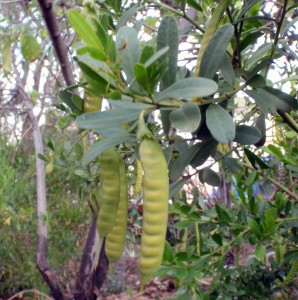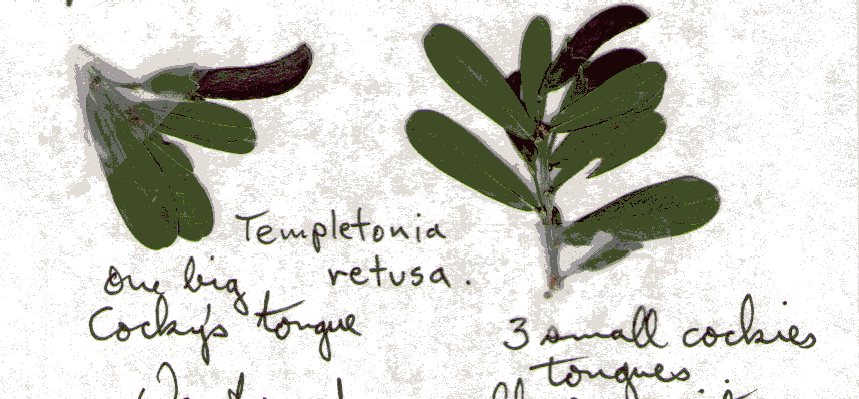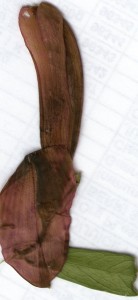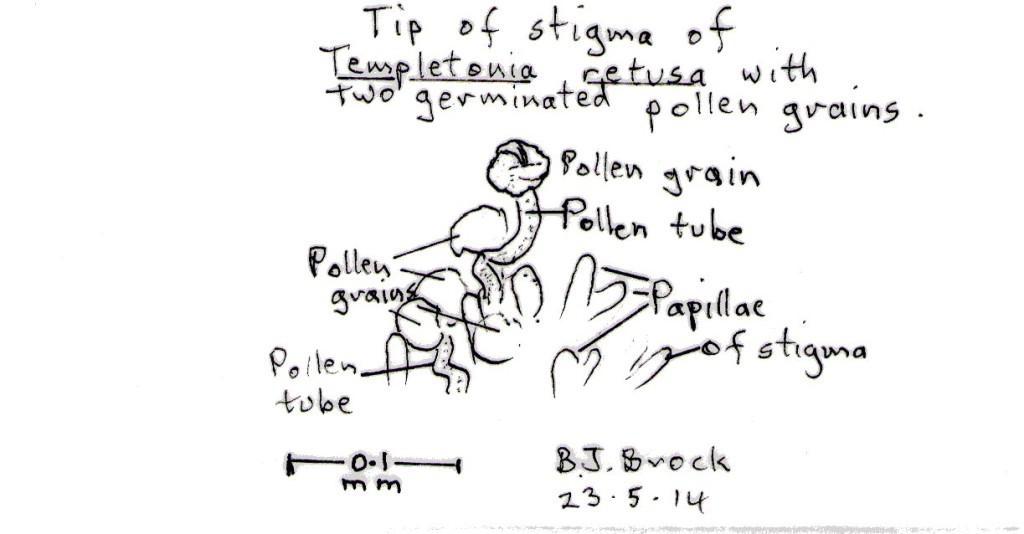As explained in Brian Brock’s 2013 Journal article “Adaptation of some Coastal Species”, Brian has had a life-long interest in coastal plants. He wrote to us several times between May & June 2014 to discuss several aspects of the subject.
An early letter from Brian said (in part), “Coleman & Cook have an interesting paper called “Habitat Preferences of the Australian Endangered Samphire Tecticornia flabelliformis” (Transactions of the Royal Society of South Australia, 2009, 133 (2):300-306).
“What is there about the genetic suite of this species that allows it to colonise the limited habitat for which it is better adapted than other halophytes? The same question could be asked about Leucophyta brownie and other halophytes that occupy limited zones. It gets down to gene suites and their influences on anatomy and plant physiology.”
A later letter in May said (in part), “I am pleased you have discovered Marion Bay. We first found it in 1969, and used it as one of our main field studies centres for over 20 years, camping in Willyama Paddock on higher ground after getting flooded out of a trackside lower site in 1970 or ’71.
Templetonia retusa paints the lower slopes of the paddock side of the Willyama Dunes in late winter and spring. I had heard of Cockies Tongue(s) (the common name for Templetonia retusa) but could never see it in the fully open flowers. Our article (“Even More on Melaleucas” in the May 2014 newsletter) prompted me to look at the specimen in my garden.
Close-up of Templetonia retusa
(Taken by Steve Reynolds)
“Cockies Tongues everywhere (no fully open flowers!). I enclose the tongue of one large cocky and two or three smaller ones.
Cockies Tongue, Templetonia retusa
1 big tongue on left, 3 small tongues on right
(The darker pieces – one is slightly hidden behind the stem & leaves)
“I agree with the common name. It is not used in my early editions of “Black’s Flora of South Australia”, but JP Jessop & HR Toelken do use it in their later edition of “Flora of South Australia”. “Shrubs & Trees for Australian Gardens”, Lord E.E. (Ed.), 1956 (Lothian) p.214 does use Cockies Tongues. So (too) does Frances Bodkin (1986) “Encyclopaedia Botanica (Angus & Robertson) p.970.
“We found a yellow variety on calcareous hills in Willyama Paddock later. Templetonia retusa gets a mention in my article “Vegetation studies in the vicinity of Penguin Point, Southern Yorke Peninsula” (SA Naturalist Vol.45, No.1, September 1970, pp 15-22).
“(It gets a mention) Also in “Tumby Bay’s Biological Bounty” (SA Naturalist Vol.50, No.4, June 1976, pp 81-87).
“(For Templetonia moth see Sims E (1980) “A Templetonian moth (SA Naturalist Vol.54 (3), pages 36, 37 & part of p.39).)
Somewhere along the line, Brian sent me this bigger sample of a Templetonia retusa flower: –
A follow-up letter from Brian (the next day) said, “I neglected to tell you about the new variety of honeyeater our bird-banders found along the paddock slope of the Willyama dunes one year. It had a lot of yellow on the head. The banders caught several like it. When they reported their discovery to a more experienced bander, he pointed out that the yellow was pollen dusted on the birds’ heads as they visited dozens of fully open Templetonia retusa flowers for their share of the early morning nectar flow. The mist nets had been set along the paddock slope of the dunes, where Templetonia retusa flourishes.
“This morning, I noticed that several of my Templetonia flowers are open. I pretended to be a honeyeater and landed on the Standard petal and probed for nectar at the base of the wings and keel of the flower, guided by the guide lines on the Standard. As the wings and keel were depressed by my heavy feet, and probing, first the stigma and style, and then the pollen-laden anthers were released from a pocket at the tip of the keel.
“This sequence of events ensures that the stigma is the first part of the flower to touch my dusty head. Then some of the pollen of the new flower is deposited on the honeyeater’s head (Brock-Honey).
“When the weight on the wings and keel is lifted (as the bird moves to another flower or flies away) the wings and keel rise, and the style and stigma, and anthers and remaining pollen, are returned to their pocket in the tip of the keel.
“So the pollen is protected from thieving insects and rain and drying heat until the next honeyeater visits.
“I see that the preferred name for Craspedia uniflora is C.glauca. I followed JM Black 1929 in my use of C.uniflora, as did the NCSSA in their list of plants found in Innes National Park in “The Vegetation of Yorke Peninsula” and in their survey of Innes National Park (MR Foale Ed.) 1977. According to my list (SA Naturalist Vol.45, No.1, September 1970, p.21), I found C.uniflora in the paddock verge near the Willyama Dunes. State Herbarium staff identified this and other species collected.
“Back to Templetonia flowers, I have found that if the keel and wings are depressed, it is possible to nip off the protruding style-tip and papillose stigma with jewellers’ forceps. I have been watching some under the microscope in the hope of seeing pollen germinate and pollen tubes grow. So far, no luck, even in 5-10% sucrose solution.
“One of my many old botany books suggested looking for germinating pollen or stigmas of older flowers. I shall try it with fading Templetonia retusa flowers.”
Within one week, Brian wrote another letter to us, saying”I was beginning to think it would be a long time before I saw germinating Templetonia retusa pollen. I only have one bush, and the stigmas did not seem to be receptive to its own pollen when the flowers first open. That could change as a last resort in older flowers.
“Fortunately during my (walks with my dog) Maddie . . I found a cluster of T.retusa shrubs flowering well at the north end of Currie Street, Nailsworth. Yesterday, I collected some of what I thought might be older flowers. Today I looked at five stigmas. One of the five had a lot of pollen on it and, to my delight, I saw about three grains with well-developed pollen tubes growing into the tip of the stigma. So I did not have to try that bush’s pollen on stigmas of flowers on my bush. That could, of course, be done.
“Herewith please find a drawing of the papillose tip of a stigma from a flower on a bush in that street cluster.
Drawing of the papillose tip of a stigma from a flower
(Drawn by Brian Brock)
“Two pollen grains show pollen tubes clearly. I have also shown the tips of some of the papillae on the stigma, and other pollen grains that have not germinated.”
(Brian added this little postscript to his above details: –
“P.S. I have seen honeyeaters visiting these bushes, and probing for nectar.”)
A later letter from Brian in June 2014 said (in part), “I hunted out the Penguin Point and Tumby Bay articles and the “Stan Slow” poem because they all had a reference to Templetonia retusa. The last stanza of the “Stan Slow” poem (reads): –
“We will remember, mate,
When the Strongy Weed flowers
And the dunes turn red in Spring
And we haul plankton from the jetty
Down Marion Bay”
(The poem “Stan Slow” by Brian is taken from “Catharias – poems by Brian J Brock”, Pioneer Books, 1981. According to another poem by Brian, “The Bottom End”, Sir Stanley Slow was a man who lived at Stenhouse Bay in 1970. “The Bottom End” is taken from “May-Day! – poems by Brian J Brock, Pioneer Books, 1985.)
Brian’s letter went on to say, “The dunes turned red because of the flowering of Templetonia retusa bushes on the lower slopes of the Willyama Dunes facing the paddock.”
REFERENCES
- “Adaptation of some Coastal Species” by Brian Brock, MLSSA Journal 2013
- “Habitat Preferences of the Australian Endangered Samphire Tecticornia flabelliformis” by“Coleman & Cook, 2009 (Transactions of the Royal Society of South Australia
- “Shrubs & Trees for Australian Gardens”, by Ernest E Lord (Ed.), 1956 (Lothian)
- “Encyclopaedia Botanica” by Frances Bodkin, 1986 (Angus & Robertson)
- “Flora of South Australia” by Jessop J.P. & Toelken H.R. Eds., 1986 (Govt. Printer, Adelaide)
- “Vegetation studies in the vicinity of Penguin Point, Southern Yorke Peninsula” by Brian Brock (SA Naturalist Vol.45, No.1, September 1970)
- “Tumby Bay’s Biological Bounty” by Brian Brock (SA Naturalist Vol.50, No.4, June 1976)
- “A Templetonian moth” by Sims E, 1980 (SA Naturalist Vol.54, No.3)





“Leucophyta brownie” in the above article should be “L.brownii”. (As explained in relation to another article, the problem with the variation in the spelling seems to be interference by the computer or the website software being used. I’m even having computer problems typing this explanation.We may yet be able to edit the original article.) Brian Brock has since explained, “The generic epithet of Leucophyta brownii ends in “ii”. The generic epithet in much of our literature is Calocephalus, but Leucophyta has precedence, having been applied by Cassini in 1823 or before, to Leucophyta brownii (See Jessop & Toelken’s “Flora of South Australia, Part III 4th Edition, 1986, Govt. Printer SA p.1502 where Cassini is acknowledged as the describer of the species in Cuvier’s Dict. Sci. Nat. 26:159 1823). I have not yet seen Cuvier’s volumes & don’t know whether it is online. I do not know where Cassini’s original description of the species occurred. Jessop & Toelken use Calocephalus brownii (Cassini) F.Muell, but give Leucophyta brownii as a synonym.”
Brian Brock also advises “In light of the use of Cockies’ Tongue for Templetonia retusa, I was interested to see Kaka Beak given as a common name for the New Zealand shrub Clianthus puniceus. Kaka is a NZ parrot. The reference is in M.Riley 1985 “New Zealand Shrubs & Small Trees” (Viking Sevenseas). I have noticed some short pods on my Templetonia retusa bush. Unfortunately, I did not label the flowers from which I nipped the stigmas, so I’ll have to wait another year to be sure that nipping off stigmas results in short-sheeted pods.”
[…] published our final Journal in 2014, after Brian had written an article titled More on the adaptations of plants that can tolerate being close to the sea which was published on our […]